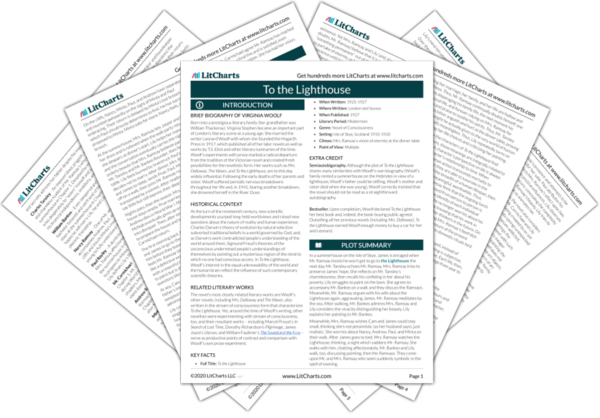Summary
Analysis
Lily observes that as soon as Mrs. Ramsay leaves, “a sort of disintegration set in.” She notes that Mrs. Ramsay is always rushing off urgently for secret reasons leaving everyone else behind.
Mrs. Ramsay’s presence exerts an aesthetic coherence on the situation around her. She makes art out of lived experience.
Themes
Quiz
Test Yourself
Mrs. Ramsay goes slowly on the stairs, wanting to be still amidst “that clatter” in order to “pick out…the thing that mattered” and “clean it of all the emotions and odds and ends” in order to have it judged by her tribunal. Thus cleaned, “the event” (the dinner) seems to have always existed and merely been revealed for the first time tonight. The revelation “struck everything into stability.” She thinks how she will forever be wound into the others’ memory of the night and is flattered by the thought.
Mrs. Ramsay herself treats lived experience like a piece of art: she extracts it, then edits it, refining it into a shape worthy of preservation. By appearing always to have existed, her finished product appears to partake of immortality. She takes pride, as an artist might, in the piece of herself preserved in the eternal art object.
Themes
Quiz
Test Yourself
Seeing the furniture on the landing that she’s inherited from her parents, Mrs. Ramsay thinks how “[a]ll that will be revived again in the lives of Paul and Minta and is filled by a “community of feeling with other people which emotion gives as if the walls of partition had become so thin” that everything “was all one stream,” communally possessed, and individual ownership is of no consequence for “Paul and Minta would carry it on when she was dead.”
The sight of her family heirlooms inspires Mrs. Ramsay to think of time as a cyclical, communal lifespan that repeats itself again and again through the ritual of marriage and is shared equally by all who enter its cycles.
Themes
Quiz
Test Yourself
Entering the nursery, Mrs. Ramsay is annoyed to find James and Cam still awake, arguing about the pig skull on the wall (which had been a gift to them and which Mrs. Ramsay had asked Mildred to remove, though it remains hanging): James likes the skull and wants to keep it up while Cam is terrified of it and claims she can’t sleep with it in the room. Mrs. Ramsay lulls Cam to sleep by wrapping her shawl around the skull and cooing stories about fairies and gardens in which the skull is just a bird’s nest. Mrs. Ramsay then assures James the skull remains there unharmed under the shawl. As she’s leaving, he asks her about the Lighthouse and Mrs. Ramsay says they won’t go tomorrow but will in the near future, resenting Mr. Tansley, Mr. Ramsay, and herself for stirring in James this frustrated hope that “he would never forget.”
An experienced mother, Mrs. Ramsay is skillfully able to predict just what each of her children wants to hear and can elaborately describe two completely opposite realities to please Cam and James separately. Again, Mrs. Ramsay worries that James will carry the disappointment of his lost trip to the Lighthouse far into the future. Since the Lighthouse functions as a symbol for human desire, James’ inability to reach it also resonates as an inability to grasp the objects of his desires more generally.
Themes
Quiz
Test Yourself
Get the entire To the Lighthouse LitChart as a printable PDF.

Mrs. Ramsay descends downstairs and finds Minta, Paul, Lily and Prue planning to go watch waves on the beach, a plan she giddily encourages, saying how much she wishes she could accompany them while feeling “withheld by something so strong that she never even thought of asking herself what it was.” When she asks if they have a watch, Paul shows her his gold one and, in doing so, intuits that she knows he’s proposed, that he needn’t tell her. Mrs. Ramsay, aloft on her giddiness, inwardly thinks how lucky Minta is to be betrothed to a man with a gold watch in a leather bag and is then “tickled by the absurdity of her thought.”
Still the eager matchmaker, Mrs. Ramsay is enthusiastic about the young people going off on a romantic adventure. The unnamed forces that keep her behind are, presumably, time and marriage: she is too old to frolic with young lovers on the beach and feels her rightful place is beside her husband. Nevertheless, Mrs. Ramsay’s whimsical reflection on Paul’s watch shows how lively and youthful her spirit is still.
Themes
Quiz
Test Yourself












